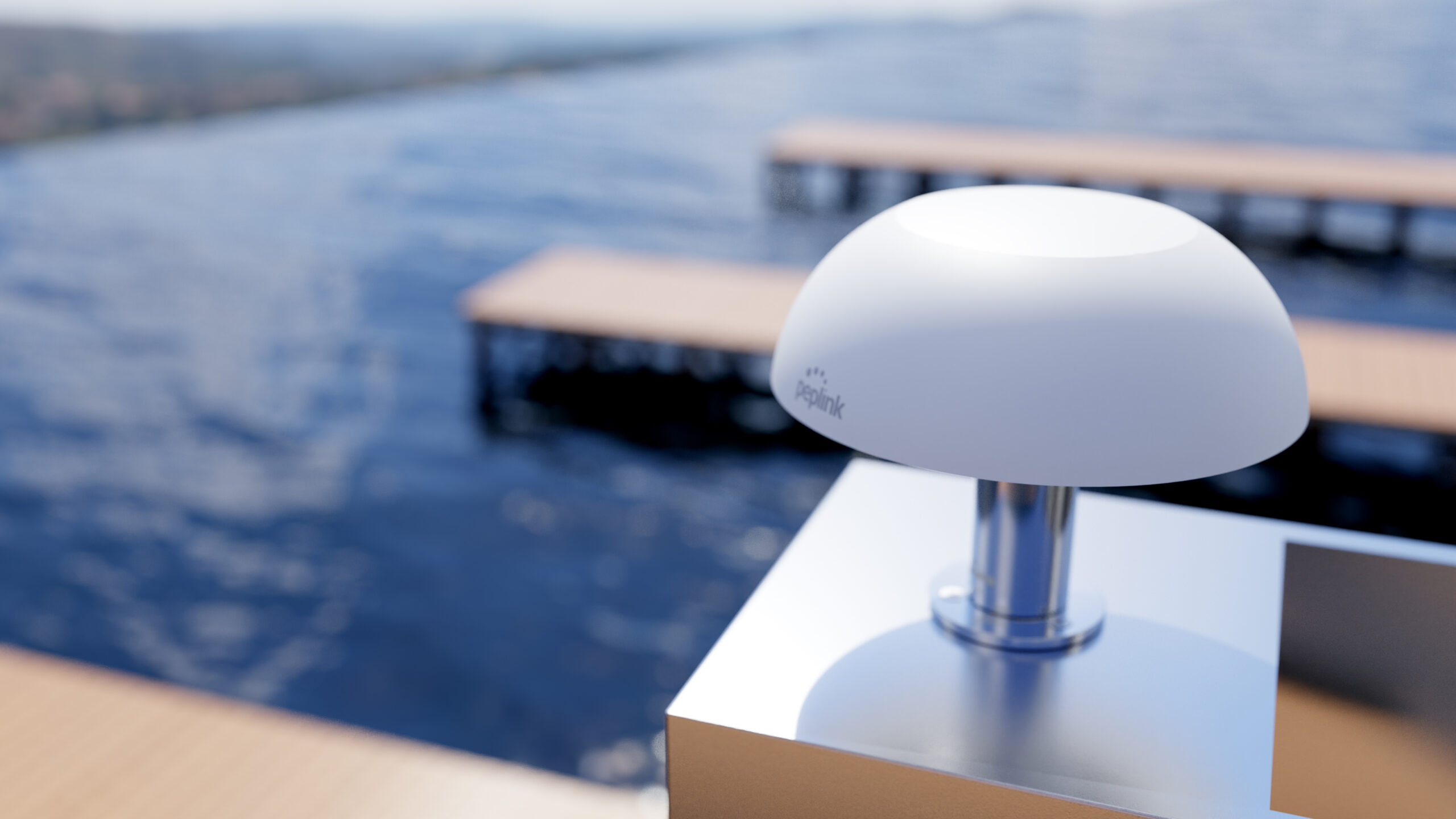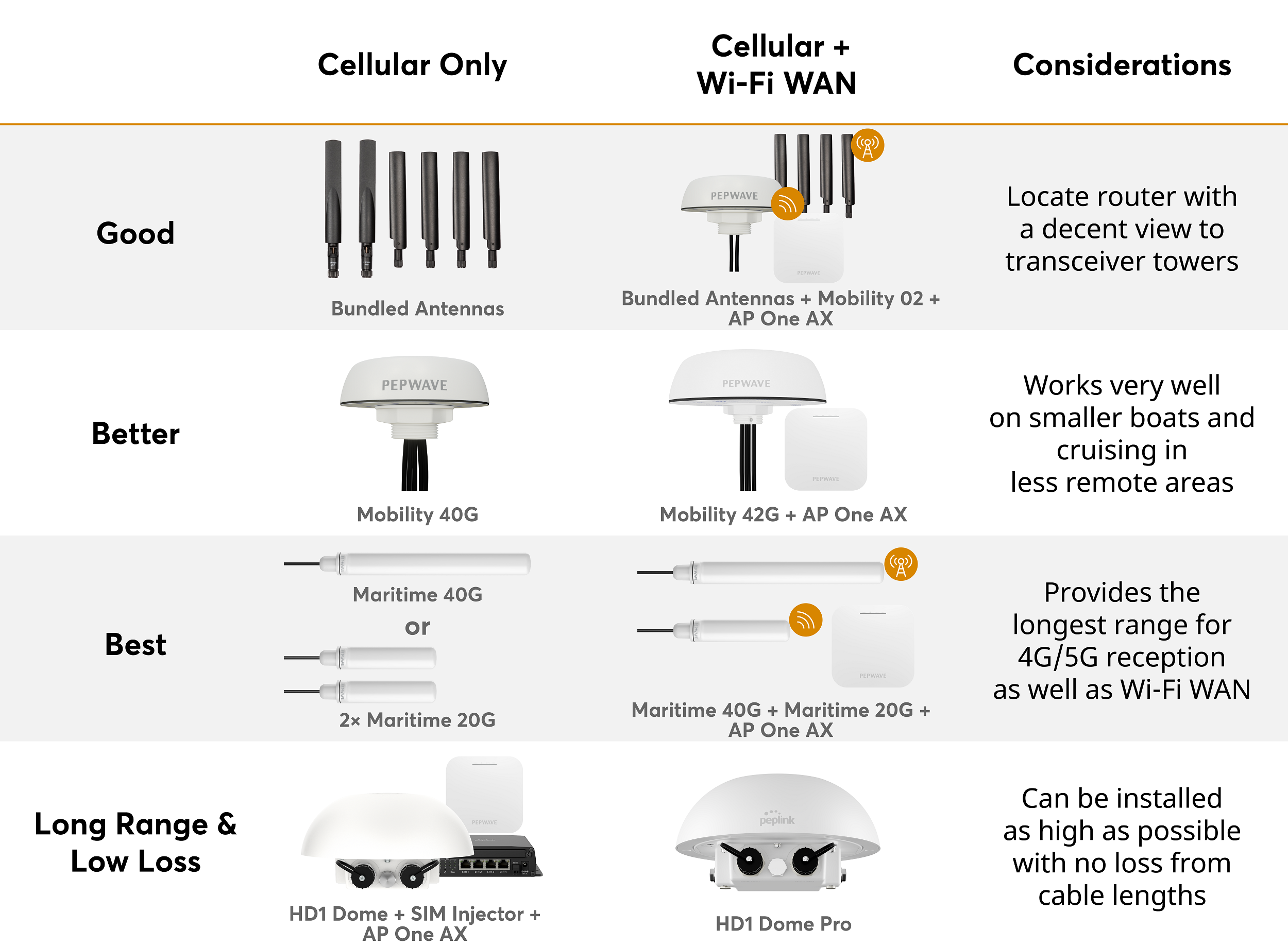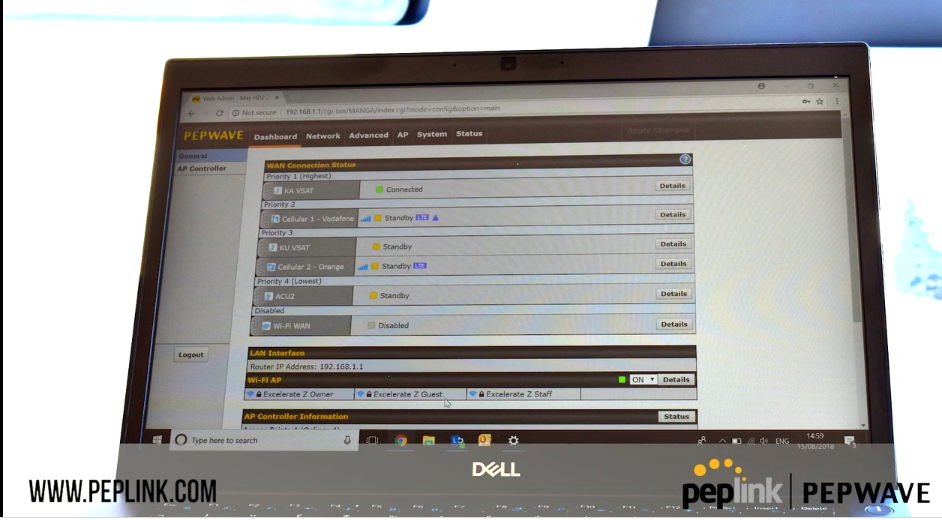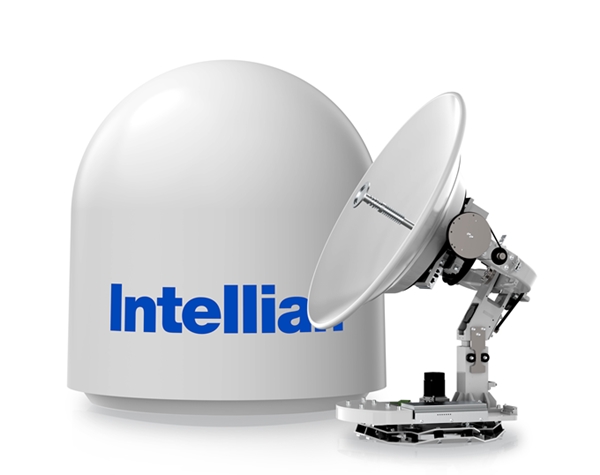The #1 question we get when we sell a cellular router for a boat is, “Will I need an external antenna?” Typically a set of external cellular and / or Wi-Fi antenna elements mounted outside your boat will give you better range and better overall performance. This article walks through both the considerations for antenna selection as well as recommendations based on your requirements.
Considerations for antenna selection
- Cellular Antenna
Before discussing antenna options, it is important to note that most routers require two or four cellular antenna connections. Modern 5G and LTE CAT-18 or better modems require four cellular antennas. CAT-6 and CAT-12 LTE modems typically use two cellular antennas.
To save the hassle of installing multiple individual antennas, there are several external antenna products that have two or four matched cellular antenna elements in a single enclosure and these elements are mounted inside to optimize spacing, diversity and orientation which greatly simplifies installation.
- Wi-Fi Antenna
In addition, modern routers typically have two Wi-Fi antenna ports. Again, these ports could be connected to individual matched single antennas or combo antennas that have multiple elements.
Wi-Fi antenna selection has its own set of considerations. Most Peplink routers have a single set of Wi-Fi radios (2.4 and/or 5GHz) connected to a single pair of Wi-Fi antennas. Yet, these radios can serve two separate functions. First, the Wi-Fi radio is used to establish an access point or “hotspot” for your boat. This Wi-Fi LAN is what your users connect their devices to.
Second, the Wi-Fi radios can also be used for Wi-Fi WAN which is the ability to connect to external Wi-Fi hotspots (such as marina Wi-Fi). This allows you to use that Wi-Fi as your connected path to the internet instead of or even in addition to cellular. However, if you plan on using Wi-Fi WAN a lot, you’ll want to locate your Wi-Fi antennas outside the cabin to get the best signal from the remote Wi-Fi source and that may compromise your onboard Wi-Fi LAN network performance if your users are far away from the Wi-Fi antennas outside. Plus if your router is using both Wi-Fi WAN and Wi-Fi LAN there is a small performance hit as the Wi-Fi radios are splitting time performing both tasks. For this reason, many customers choose a strategy of using the router for external communications via cellular and Wi-Fi WAN, and add a dedicated access point device inside the cabin to provide Wi-Fi LAN functionality.

(Peplink MAX MBX 5G Router and AP One AX Access Point Inside the Cabin)
Factors that will impact antenna installation
Before considering which external antenna to purchase, there are some factors that will impact any antenna installation:
Location: The antenna needs to be installed far from other vertical metal and transmitting antennas or devices if possible. NMEA (National Marine Electronics Association) typically recommends 2-6 feet separation depending on the type of the other antenna. Cellular antennas should never be installed in the beam of a radar. Keep in mind any vertical metal can cause interference or reflection which can degrade the performance of the router / antenna combo.
Cable length: Antenna cables that are too long are often the downfall of many antenna installations. HDF-195 (aka LMR-195) is widely used for the six-foot cables attached to many antennas as well as for shorter extension cables. We don’t recommend having a total cable run of more than 20 feet if you are using HDF-195. Using the Times Microwave Coax Cable Attenuation Calculator, you can see that for 5000Mhz the loss is 6.2dB plus probably another 0.5dB loss for the mid-point connector. For longer runs you will need to step up to LMR-400 UltraFlex which brings the loss down to 2.8dB for 20 feet but that presents a new set of challenges as you plan for cable routing. Given this, the goal is to install the router as close as possible to the antenna installation area in order to minimize loss from cable runs. Otherwise, if your cable run is too long you will defeat the point of installing an external antenna.
Antenna size and esthetics: External antennas range in size from small, lightweight domes such as the Peplink Mobility 40G 4×4 MIMO LTE/5G/GPS Antenna to large and heavy “stick” style antennas like the Peplink Maritime 40G 4×4 MIMO LTE/5G/GPS Antenna. The larger antenna will typically perform better but may be a beast to install on your antenna array arch or aft rail. We have seen many customers also choose to use two antennas instead of one for visual balance, such as using two Peplink Maritime 20G Antennas with a typical 4×4 cellular modem setup.
Performance and range goals: As they say, the bigger the better. The bigger the antenna elements along with an installation location free and clear from surrounding clutter will typically result in the best possible range and fastest speeds. With that in mind, the three-foot Peplink Maritime 40G Antenna has been the go-to antenna for folks wanting reception in the most remote areas. But if your performance requirements are less demanding, you are cruising in more populated areas or if you have a smaller boat, then a small external dome style antenna may be more appropriate and work very well.

(Peplink Maritime 40G Antennas Secure You with the Best Possible Reception)
Wi-Fi WAN: If connecting to external marina and public Wi-Fi is important then install external Wi-Fi antennas and use a separate dedicated access point (AP) such as the Pepwave AP One AX Lite Wireless Access Point in the cabin.
Other options: A creative way to address many of these challenges is to go with a solution that has the cellular modem and antennas located in the same enclosure.
An option for doing this is to go with the Peplink MAX HD1 Dome LTE Router which is a Power-over-Ethernet (PoE) CAT-18 LTE-A modem inside a 4×4 cellular antenna dome or even the new Peplink MAX HD1 Dome Pro Router with a 5G router and Wi-Fi antennas. Install your SIM cards in the dome or use the optional Peplink SIM Injector and bring a single ethernet cable down to a PoE inserter and your access point in the cabin.
For this solution, you can locate the modem/antenna set pretty much anywhere you like and lead no-loss ethernet down to your cabin.

(Peplink HD1 Dome Pro Router Deployed Outdoors)
Recommendations
Given all that, which antenna setup should you choose?
Here is our basic set of recommendations on Peplink antenna setups based on whether you plan on using a lot of Wi-Fi WAN or not.







